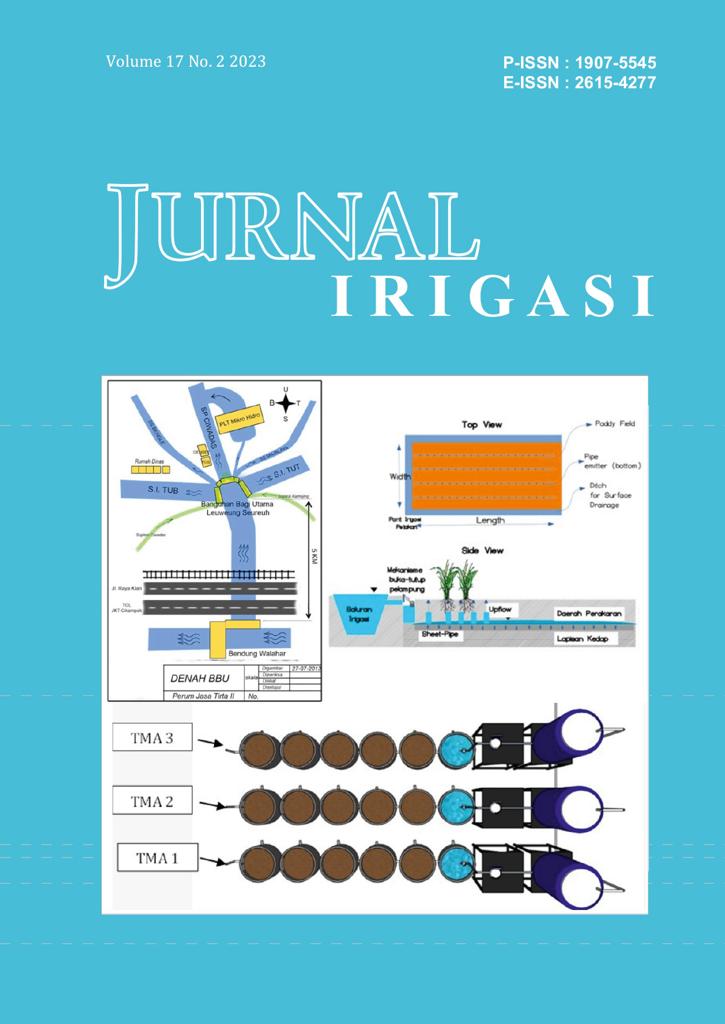Irrigation operation and maintenance management system integration of irrigation water rotation scheduling
DOI:
https://doi.org/10.31028/ji.v17.i2.37-44Keywords:
K factor, water balance, irrigation operation, SMOPI, water supply rotationAbstract
The gap between water availability and water demand can be a significant challenge for the operation of the irrigation network. One approach to addressing this issue is to implement a rotational system for water distribution. However, while a proportional rotation schedule can ensure better uniformity, additional technical variables should be considered to further improve irrigation services. This study aims to create and apply methods for rotational water delivery systems by considering location, sufficiency, equity, and timeliness. This method was implemented as a module on the Irrigation Operations and Maintenance Management System (SMOPI), which has been widely used in many irrigation areas in Indonesia. During water shortage, particularly when the K factor is less than 70%, this module could be activated. Each criterion is integrated with the factual information inputted by the officer in the SMOPI to schedule the irrigation rotation. This study was conducted as a case study in the Ciliman Irrigation Area Banten. Based on simulation result, the proposed method led to an increase in planting area of approximately 7% of the area. This tool could be beneficial for field officers in calculating and distributing irrigation water while optimizing the amount of water allocated to each tertiary plot.
Downloads
References
Afrasiabikia, P., Parvaresh Rizi, A., & Javan, M. (2017). Scenarios for improvement of water distribution in Doroodzan irrigation network based on hydraulic simulation. Computers and Electronics in Agriculture, 135, 312–320. https://doi.org/10.1016/j.compag.2017.02.011
Delgoda, D., Malano, H., Saleem, S. K., & Halgamuge, M. N. (2017). A novel generic optimization method for irrigation scheduling under multiple objectives and multiple hierarchical layers in a canal network. Advances in Water Resources, 105, 188–204. https://doi.org/10.1016/j.advwatres.2017.04.025
Efendi, A., Harisuseno, D., & Prayogo, T. B. (2019). Peningkatan intensitas tanam padi melalui pemanfaatan debit surplus sungai, penerapan sumur renteng, dan sistem giliran. Jurnal Irigasi, 14(1), 1–16. https://doi.org/10.31028/ji.v14.i1.1-16
Faishal, A. (2013). Evaluasi Ketersediaan dan Kebutuhan Air untuk Pertanian DI Boro Kabupaten Purworejo Provinsi Jawa Tengah (Skripsi). Universitas Gadjah Mada, Yogyakarta, Indonesia. Diperoleh dari http://etd.repository.ugm.ac.id/home/detail_pencarian/64809
Food and Agriculture Organization (Ed.). (2011). The state of the world’s land and water resources for food and agriculture: Managing systems at risk (1st ed). Milton Park, Abingdon ; New York, NY: Earthscan.
Hansen, V. E., Israelsen, O. W., & Stringham, G. E. (1979). Irrigation Principles and Practices (4th ed). New York, USA: John Wiley and Sons.
Kaur, S., Srivastava, D. K., & Arya, D. S. (2013). Improved Planning Model for Canal Scheduling of Rotational Irrigation. Journal of Irrigation and Drainage Engineering, 139(7), 560–570. https://doi.org/10.1061/(ASCE)IR.1943-4774.0000575
Kementerian PUPR. (2015). Peraturan Menteri Pekerjaan Umum dan Perumahan Rakyat No. 12/PRT/M/2015 tentang Eksploitasi dan Pemeliharaan Jaringan Irigasi.
Li, M., Fu, Q., Singh, V. P., & Liu, D. (2018). An interval multi-objective programming model for irrigation water allocation under uncertainty. Agricultural Water Management, 196, 24–36.https://doi.org/10.1016/j.agwat.2017.10.016
Permana, C. D. (2019). Studi Evaluasi Kebutuhan Air Irigasi Dan Penyusunan Jadwal Pembagian Air Irigasi Pada Daerah Irigasi Molek Kecamatan Kepanjen Kabupaten Malang (Disertasi). Universitas Brawijaya, Malang, Indonesia.
Pusat Pendidikan dan Pelatihan Sumber Daya Air dan Konstruksi. (2017). Modul Pelaksanaan Operasi Jaringan Irigasi. Diperoleh dari https://simantu.pu.go.id/epel/edok/d2e82_Modul_Operasi_dan_Pemeliharaan.pdf
Rahman, A. L., Fauzi, M., & Sujatmoko, B. (2019). Sistem Pemberian Air secara Rotasi Daerah Irigasi Kaiti Samo di Kabupaten Rokan Hulu. Jurnal Teknik, 13(1), 43–51. https://doi.org/10.31849/teknik.v13i1.2931
Santhi, C., & Pundarikanthan, N. V. (2000). A new planning model for canal scheduling of rotational irrigation. Agricultural Water Management, 43(3), 327–343. https://doi.org/10.1016/S0378-3774(99)00065-7
Sayonara, R., & Siswoyo, R. D. (2019). Optimasi debit dengan memaksimalkan luas lahan pertanian guna mendapatkan hasil produksi pertanian yang maksimal pada Jaringan Irigasi Weliman di Kabupaten Malaka. JUTEKS: Jurnal Teknik Sipil, 4(1), 18–27.
Sofiyuddin, H. A., & Rahmandani, D. (2019). Akselerasi waktu pelaporan operasi irigasi menggunakan perangkat lunak berbasis web Sistem Manajemen Operasi dan Pemeliharaan Irigasi (SMOPI). Jurnal Irigasi, 14(2), 63–78. https://doi.org/10.31028/ji.v14.i2.63-78
Utaminingsih, W., Hidayah, S., Sofiyuddin, H., Zukhrufiyati, A., & Susilowati, S. (2019). SMOPI Menjawab Tantangan Pengelolaan Irigasi. Bandung, Indonesia: Puslitbang Sumber Daya Air.
Downloads
Published
How to Cite
Issue
Section
License
Copyright (c) 2023 Jurnal Irigasi

This work is licensed under a Creative Commons Attribution-ShareAlike 4.0 International License.
This work is licensed under a Creative Commons Attribution-ShareAlike 4.0 International License.
